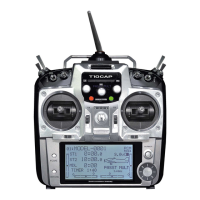End Point of servo travel adjustment (
END POINT
, also called EPA): the most flexible version of travel adjustment
available. It independently adjusts each end of each individual servo’s travel, rather than one setting for the servo that
affects both directions. Again, for CCPM helicopters, be sure to see
SWASH AFR
(see p. 95) prior to adjusting end points.
Adjustability:
• Can set each direction independently.
• Ranges from 0% (no servo movement at all) to 140%. At a 100% setting, the
throw of the servo is approximately 40° for channels 1-4 and approximately 55
° for channels 5-8.
• Reducing the percentage settings reduces the total servo throw in that direction.
Examples:
• Adjust the throttle high end to avoid binding at the carburetor, and low end to allow for proper carburetor closure.
$GMXVWÀDSVRXSWUDYHOLVRQO\VXI¿FLHQWIRUVWUDLJKWDQGOHYHOÀLJKWWULPPLQJZLWKIXOOGRZQWUDYHO
•
END POINT
PD\EHDGMXVWHGWRWRNHHSDVHUYRIURPPRYLQJRQHGLUHFWLRQVXFKDVÀDSVQRWLQWHQGHGWRDOVRRSHUDWHDV
spoilers.
• Retract servos are not proportional. Changing
END POINT
will not adjust the servo.
END POINT
adjusts only the individual servo. It will have no effect on any other servo that is operated in conjunction with
this servo via mix or preset programming such as
FLAPERON
,
AILEVATOR
, etc. This is so that each individual servo can be
FDUHIXOO\¿QHWXQHGWRDYRLGELQGLQJDQGRWKHUFRQÀLFWV7RDGMXVWWKHWRWDOWUDYHORIDIXQFWLRQVXFKDV
FLAPERON
, make
the adjustments in that function's controls. For CCPM helicopters, adjust the total travel of the function, such as collective
pitch, in
SWASH AFR
.
Adjust the linkage or the
END POINT
? It is nearly always best to adjust your linkages to get as close as possible prior to
utilizing
END POINT
. The higher the
END POINT
setting, the better position accuracy and the more servo power available
at nearly any position (except if using digital servos). Higher
END POINT
values also mean longer travel time to reach the
desired position, as you are utilizing more of the servo's total travel. (For example, using 50%
END POINT
would give you
only half the steps of servo travel, meaning every click of trim has twice the effect and the servo gets there in half the
time).
• end point (and moving the linkage) = torque, accuracy, but transit time to get there.
• end point (instead of adjusting linkages) = travel time, but torque, accuracy.
GOAL of EXAMPLE: STEPS: INPUTS:
Decrease the flap servo throw in the
upward direction to 5% to allow
WULPPLQJRIOHYHO ÀLJKWRQO\DQGGRZQ
travel to 85% to prevent binding.
Open
END POINT
function.
for 1 second.
(If
ADVANCE
, again.)
C
to
END POINT
.
Choose proper channel and move stick
or knob in direction you want to adjust
DQGVHWVHUYRWKURZ([ÀDSXS
C
to
FLAP
.
ÀDSFRQWURO>GHIDXOWLVVR(A)].
to
5%
.*
VR(A). to
85%
.
Close.
Where next? Go to
SERVO
GLVSOD\WRFRQ¿UPGHVLUHGHQGUHVXOWVHHS
0RYHDX[LOLDU\FKDQQHOVWRGLIIHUHQWGLDOVVZLWFKHVVOLGHUVVHHS
Set up
IDLE-DOWN
and
THR-CUT
WRVORZFXWWKHHQJLQHVHHS
6HWXSGXDOWULSOHUDWHVDQGH[SRQHQWLDO
D/R
,
EXP
): see p. 42.
6HWXSÀLJKWWLPHUVVHHS
Set up trainer functions: see p. 47.
Set up twin aileron servos: see p. 51.
Set up twin elevator servos: see p. 57.
*You can reset to the initial values by pressing the DIAL for one second.

